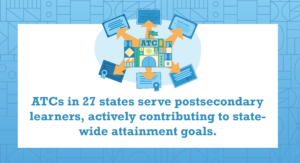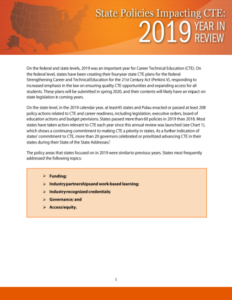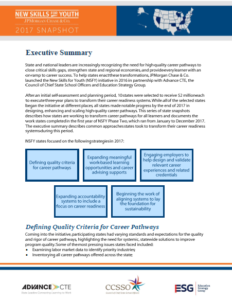 Advance CTE’s recent report on area technical centers (ATCs), Building Better Futures for Learners: A 50-State Analysis of Area Technical Centers, revealed that ATCs have a notable footprint in credential and non-degree programs for postsecondary learners and an active role in contributing to state postsecondary attainment goals. However, the extent of their impact varies across states and territories and is strongly influenced by policymaker awareness and systems alignment.
Advance CTE’s recent report on area technical centers (ATCs), Building Better Futures for Learners: A 50-State Analysis of Area Technical Centers, revealed that ATCs have a notable footprint in credential and non-degree programs for postsecondary learners and an active role in contributing to state postsecondary attainment goals. However, the extent of their impact varies across states and territories and is strongly influenced by policymaker awareness and systems alignment.
At the time of our report, forty-five states had set a goal to increase postsecondary attainment. This trend is largely inspired by the work of Lumina Foundation, a national leader in advancing access and outcomes in postsecondary education that set a national goal of equipping at least 60 percent of the working age population with a postsecondary degree or credential by 2025. Expanding access to and providing seamless transitions for learners in their journey to postsecondary attainment is critical to an equitable national economic recovery.
This post will focus on highlighting several states that offer best practices to elevate the role of ATCs in postsecondary attainment through state oversight, the role of ATCS in statewide postsecondary attainment plans, and statewide systems alignment.
For a broader breakdown of topline messages from this report and implications for states, please read our most recent post on Medium.
State Oversight
One of the report’s key policy recommendations is for states to improve the awareness, accountability, and alignment of ATCs through the restoration or enhancement of state oversight of these institutions.
Utah and Oklahoma provide strong examples of the benefits of robust state oversight and positioning of ATCs. Utah’s area technical centers, known as technical colleges, were recently elevated and designated as eight of the state’s 16 postsecondary institutions under the Utah System of Higher Education. This positioning was a solution to years of legislative changes that had created two systems of higher education, leading to legal and learner navigation difficulties that limited the potential of ATCs. This new position for ATCs enhances learner equity by providing well-aligned pathways from ATCs to four-year postsecondary institutions and uniform credit transfer policies.
Oklahoma has a separate state agency, known as CareerTech, that oversees all aspects of their CTE delivery system, including 29 ATCs known as technology centers. In addition to serving as the fiscal agent for the state’s robust allotment of CTE funding, the agency also provides oversight of program quality. CareerTech partners with other state agencies to ensure that the needs of underserved populations, including the Indian Education Board and Tribal Reintegration Program and the Department of Veteran Affairs are met.
The Role of ATCs in State Postsecondary Attainment Plans
While most states reported that ATCs were not specifically mentioned in postsecondary attainment plans, the vast majority strongly agreed or agreed that their ATCs were active contributors to postsecondary attainment goals.
Delaware’s ATCs have a significant role in supporting the state’s postsecondary attainment goal through the administration of the state Registered Apprenticeship program. This program constitutes almost 70 percent of the state’s vocational/technical school district postsecondary and adult population and allows ATCs to be strongly connected and responsive to state workforce needs despite predominantly local oversight.
Florida’s ATCs, known as technical colleges, are strongly tied to the state’s attainment goals. Because Florida’s ATCs are accredited by the Council on Occupational Education, they must maintain a 60 percent learner completion rate and 70 percent licensure exam pass rate, effectively exceeding the state’s postsecondary attainment goal. Technical colleges are the focal point of a statewide Get There campaign that combines program grants colleges with a public relations campaign to promote postsecondary attainment through a short-term credential of value.
High-quality and timely state-level data collection is key to accurate measurement and evaluation of the impact of ATCs on postsecondary attainment. In Oklahoma, the state’s technology centers contributed over 19,000 industry-recognized credentials with an 88 percent adult learner program completion rate in FY2018. Florida reported over 9,000 earned industry certifications and over 14,400 full program completers through its technical colleges for the 2019-2020 academic year.
Statewide Systems Alignment
While 27 states reported providing some level of programming at ATCs to postsecondary learners, their responses also indicated that ATCs are often disconnected from the larger postsecondary system. A few states stand out as exemplars in intentional alignment between ATCs and higher education systems.
Ohio includes its ATCs, known as Ohio technical centers (OTCs), in a statewide articulation and transfer agreement established in 2007 known as Career-Technical Credit Transfer. When combined with Career-Technical Assurance Guides that advise learners through the transfer process, these tools give learners and their credits seamless and equitable pathways from OTCs to other postsecondary institutions. Numerous OTCs have also partnered with regional community colleges to design coursework sequences that span both institutions for improved program quality and alignment.
Florida’s technical colleges are required to achieve seamless articulation and transfer agreements under state law. Technical and state colleges must create regional career pathway articulation agreements that align a technical college program with a degree program at a state college. Clock hours must also be transferable to the aligned state college degree program.
Effective alignment practices also extend to the relationship between ATCs and workforce development systems. In Delaware, ATCs are members of a statewide CTE alliance that includes representatives from vocational/technical school districts, the technical and community college system, and other state agencies and workforce partners. Collaborative efforts from this alliance expanded the state’s Registered Apprenticeship programs to include pre-apprenticeship and secondary learners, and more career pathways that span multiple institutions.
We hope these examples provide valuable insight on potential reforms for states to leverage and elevate ATCs. Visit our microsite to access full state profiles for the five states mentioned in this post. A future post will explore the potential use of ATC in economic recovery plans and highlight innovative partnerships in states.
Stacy Whitehouse, Senior Associate Communications and State Engagement


 On the federal and state levels, 2019 was an important year for Career Technical Education (CTE). In addition to creating their four-year state plans for the federal Strengthening Career and Technical Education for the 21st Century Act (Perkins V), at least 45 states and Palau enacted at least 208 policy actions related to CTE and career readiness.
On the federal and state levels, 2019 was an important year for Career Technical Education (CTE). In addition to creating their four-year state plans for the federal Strengthening Career and Technical Education for the 21st Century Act (Perkins V), at least 45 states and Palau enacted at least 208 policy actions related to CTE and career readiness. Through NSFY, Delaware, Kentucky, Louisiana, Massachusetts, Nevada, Ohio, Oklahoma, Rhode Island, Tennessee and Wisconsin took action to:
Through NSFY, Delaware, Kentucky, Louisiana, Massachusetts, Nevada, Ohio, Oklahoma, Rhode Island, Tennessee and Wisconsin took action to: The Met, a work-based learning focused technical center in Providence, Rhode Island, serves about 800 students across the state. It is also one of eight recipients of
The Met, a work-based learning focused technical center in Providence, Rhode Island, serves about 800 students across the state. It is also one of eight recipients of  Throughout history, and continuing today, learners of color, low-income learners, female learners and learners with disabilities have been historically tracked into terminal vocational programs leading to jobs with uncertain promise of economic growth and prosperity. While the quality of CTE programs has significantly improved since then, many of these same learners cannot access high-quality CTE programs of study that prepare them for success in postsecondary education and their future careers.
Throughout history, and continuing today, learners of color, low-income learners, female learners and learners with disabilities have been historically tracked into terminal vocational programs leading to jobs with uncertain promise of economic growth and prosperity. While the quality of CTE programs has significantly improved since then, many of these same learners cannot access high-quality CTE programs of study that prepare them for success in postsecondary education and their future careers. The
The  What defines a high-quality career pathway? Is it alignment to labor market needs and career opportunities? The quality and qualifications of teachers and faculty? Access to meaningful, aligned work-based learning experiences? Perhaps all of the above?
What defines a high-quality career pathway? Is it alignment to labor market needs and career opportunities? The quality and qualifications of teachers and faculty? Access to meaningful, aligned work-based learning experiences? Perhaps all of the above?